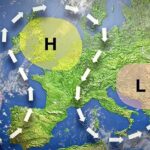
De gewraakte IPCC-grafiek
Hoewel mijn eerste indruk van het PBL-rapport gematigd positief is (gematigd omdat ik de opdracht om alleen naar acht hoofdstukken over regionale klimaatverandering te kijken weinig interessant vond, maar dat kunnen we de auteurs verder niet aanrekenen natuurlijk), zijn de eerste foutjes alweer ontdekt.
Roger Pielke jr laat op zijn blog weten dat het PBL een claim van het IPCC over schade door orkanen ten onrechte heeft goedgekeurd. Dit stond in het PBL-rapport op pag. 78:
Figures TS.15 and 14.1 on the economic damages from hurricanes. (minor)
Figures TS.15 (Technical Summary, page 55) and 14.1 (Chapter 14, page 621) in the Working Group II Report illustrate the statement in the Technical Summary that reads ‘Over the past several decades, economic damage from hurricanes in North America has increased over fourfold, due largely to an increase in the value of infrastructure at risk’. We have a minor comment to make on the figures. Because of a shorter averaging period at the end of the time series (6 years instead of 10), the most recent increase was higher, compared with the increase that would have resulted from applying a uniform averaging period at the end of the series. However, a different choice of statistical method would not have affected the statement. Furthermore, we have found this statement to be fully supported by the underlying material. This minor comment has no consequences for the IPCC conclusions in the various Summaries for Policymakers.
Het PBL constateerde slechts een klein probleem met de manier waarop eindpunten in de grafiek waren behandeld maar vond de claim zelf – een viervoudige toename van de schade – dus in orde. De grafiek in het IPCC-rapport is gebaseerd op Pielke/Landsea 1998, echter met data verder aangevuld. Pielke heeft zelf geen idee waar de extra data vandaan komen. De volgens hem correcte grafiek ziet er zo uit:

Genormaliseerde verliezen door orkanen
Klimaatsignaal
De crux is dat in deze grafiek al gecorrigeerd is voor economische en maatschappelijke veranderingen. Wat nu nog te zien is in de grafiek is het gevolg van veranderingen in het klimaat, aldus Pielke. Een toename aan schade zou dus het gevolg kunnen zijn van klimaatverandering. Maar het is duidelijk dat de grafiek vrijwel geen trends laat zien. Van een verviervoudiging is dus absoluut geen sprake en dit was geen minor maar een major error.
Een foutje is menselijk, zelfs als je bezig bent met het onderzoeken van mogelijke foutjes. Het wordt echter een beetje knullig als we van Pielke moeten vernemen dat de PBL-auteurs met hem persoonlijk contact op hadden genomen hierover:
Overall, the NEAA report looks to be a valuable effort in assessing the IPCC WGII regional chapters. However, on the topic of hurricane losses in the United States, the NEAA is in obvious error, which is unfortunate because the issue is so straightforward.
Zeespiegel in Afrika
In de eerste zin van dit bericht had ik het over foutjes en niet een foutje. In de commentaren onder Pielke’s bericht meldt onze landgenoot en kersverse lead author voor AR5, Richard Tol, zich:
IPCC:
Towards the end of the 21st century, projected sea level rise will affect low-lying
coastal areas with large populations. The cost of adaptation could amount to at least
5 to 10% of Gross Domestic Product (GDP).PBL:
The first sentence of this statement is fully supported by the underlying material.
We have a comment to make about the second sentence of the statement, which
was based on a table in a study by Niang-Diop (2005). The text does not explicate
how the experts derived the 5 to 10% in adaptation costs from this study, since
it covered a range from 0.5 to 156.2% (C3). The IPCC authors explained to us that
they used 5 of 12 studies summarised in the table in Niang-Diop (2005). Those that
Africa scored below the range of 5 to 10% were either countries that did an assessment
not covering the entire country (Cameroon: 0.5%; Gambia: 1%), or those with a very
short coastline (Democratic Republic of the Congo: 4.1%), or relatively rich countries
(Nigeria: 2.2%). Those that scored well above this range were either very small island
states (Comoros: 49.7%) or countries for which the costs had been overestimated
(Mauritania: 156.2%). This answer explains the 5 to 10% range. We believe it would
have been helpful if this explanation had been provided in Chapter 9.Tol:
Why did the IPCC exclusively rely on Niang-Diop? Why did the IPCC not also use results by Nicholls and Tol?The sentence “could amount to at least 5 to 10% of gross domestic product” suggest that this is true throughout Africa — while in fact the evidence is that this is true only in the vulnerable countries of Africa.






waarbij opgemerkt moet worden dat ik mijn oog op een willekeurige pagina heb laten vallen, en alleen deze passage heb gelezen …
Een foutje is menselijk, de vraag is hoe komt het dat het ALTIJD ten voordele van de AGW is? Tunnelvisie? Wens vader van de gedachte? In ieder geval, NIET wetenschappelijk.